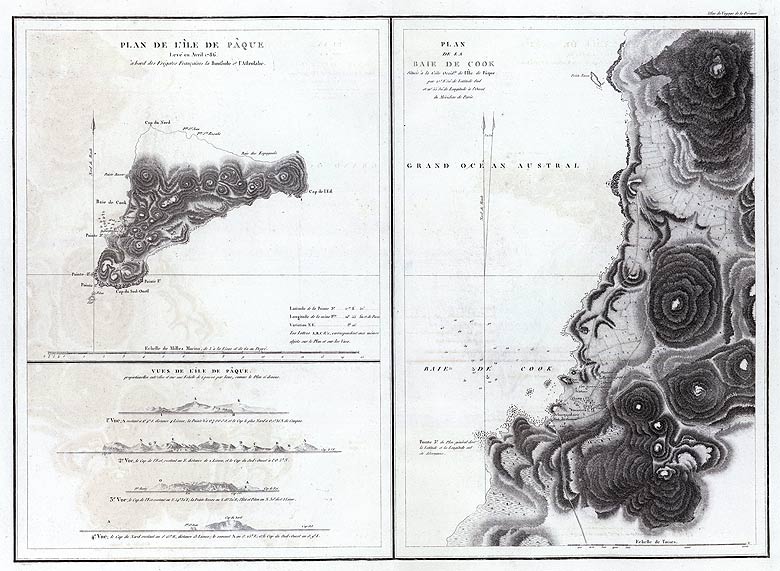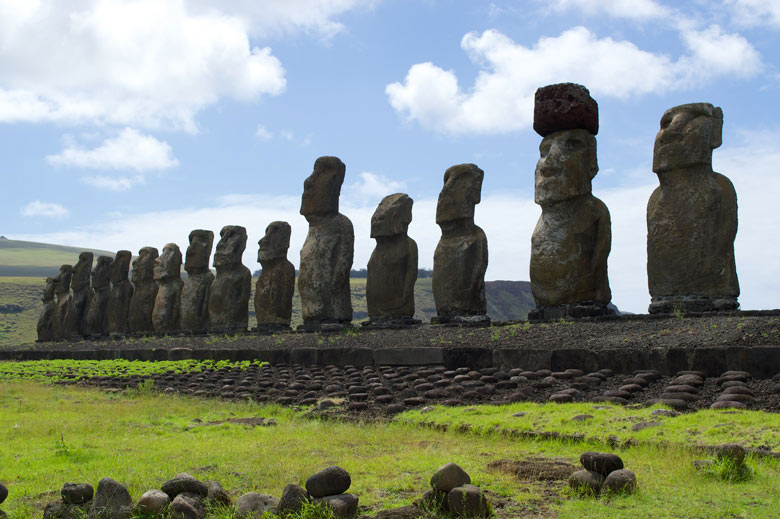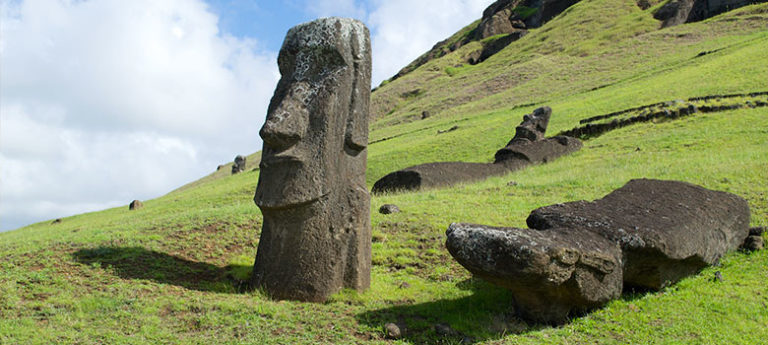Easter Island: Moai Statues
© KarmaWeather by Konbi - All rights reserved
Cover picture by Tristan Smith (source, license) Changes: framing
History, facts, legends and travel guide about the Moai statues, Easter Island's most mysterious landmarks
Easter Island
History and Geography (part 1)
Easter Island ("Rapa Nui" in Polynesian, "Isla de Pascua" in Spanish) is a triangular-shaped island with an area of 162 km2, located southeast of the Pacific Ocean, with a population of of 6400 people. Inhabited by the Polynesian community, the "Rapanui", it was successively occupied by the Spanish and French before becoming a Chilean possession since 1888 (continuation below).
Planning a travel to Easter Island
Distance between Easter Island and the nearest land
- Tahiti is 4231 km west
- Santiago, Chile is 3756 km east
- Mexico City is 5686 km north
- Hawaii is 7214 km northeast
How to get to Easter Island?
- By plane
- By boat
Whether you come from Great Britain, Spain, Australia or the United States, the intermediate step before reaching Easter Island is Chile. From Santiago, the capital of Chile, the daily flight of the company LAN Airlines to Easter Island is the only reliable means of transport for. It takes 6 hours of flight before landing on the mysterious lands of the forgotten Matamua civilization. Expect between 250 and 450 € for the return flight.
No sea line currently exists to reach Easter Island. In view of the great distances from Easter Island with the nearest land and unless you're a veteran sailor, it is best to stick to the air travel option.
What is the minimum budget for visiting Easter Island?
The biggest part of the budget for a holiday in Easter Island is the price of the plane (between 250 and 450 €), to which we must add about 50 € for the price of the access ticket to the National Park of the island. Then everything depends on your means. If you are a hiker, clean and cheap accommodation in campsites exist near the beaches of this extremely peaceful and safe island.
Of a sporting nature, you can also just rent a bike rather than a scooter or a car. Finally, if you have a limited budget, eating canned food, avoiding lodging at the hotel, eating out and participating in organized tours and excursions, your budget for a week at Easter Island can be € 350, or € 50 per day (not including the cost of the plane).
History and Geography (part 2)
The island is named after the first European who set foot there, the Dutchman Jakob Roggeveen (1659 - 1729), the Passover Sunday of April 6, 1722. Easter Island, with its more than 1000 monumental sculptures of basalt (volcanic rock), the "Moai", is exceptional to the point that it is registered in the Unesco World Heritage.
Easter Island Facts
When did the first inhabitants of Easter Island arrive?
Why Moai statues were built?
The visit of prestigious explorers
The mystery of the transport of Moai statues
The Moai statues remain sacred
Consequences of climate change for Easter Island
The date of the original settlement of Easter Island by Polynesian navigators is difficult to determine. It would be between the years 400 and 1200, the most recent period being more credible in the eyes of contemporary archaeologists.
Originally carved on a human scale in the 12th century, the Moai become larger and larger with time, reaching an average height of 4 to 9 meters (with their red volcanic tuff cap, the "pukao") and a weight of 15 to 80 tons when their production stopped in the 16th century. Nobody really knows what their real function was, even though their position on the outskirts of the island clearly suggests that they played a role of spiritual protection and perhaps also a powerful deterrent against possible marine invaders, frightened by the seen from these giants of stone. Similarly, the orientation of the statues, the body turned towards the interior of the island, probably had a protective role for the villages, such as ancestors avoiding their children from falling into disputes or deadly wars. For it is extremely likely that the Moai statues were the object of an ancestor worship and that a prestigious competition between the different clans of the island could push the big families to compete in a race to gigantism of the monoliths.
Several famous navigators and explorers had the opportunity to visit Easter Island following Jakob Roggeveen. Among them, the Spanish Felipe Felipe González de Ahedo (1714 - 1802) in 1770, who mistook the identity of the island, the English Jame Cook (1728 - 1779) in 1774 and the French Jean-François de la Pérouse (1741 - 1788) in 1786.

The volcanic tuff extracted for use in the construction of Moai sculptures comes mainly from Rano Raraku's quarry. In view of the many unfinished sculptures present on this ancient quarry, it is possible to conclude that the blocks of stones were carved before being transported to their place of construction, where, anchored deeply in the ground, the lower body sometimes buried to the chest, they were then given their red stone headdress and their eyes. The ceremonial platforms scattered around the edges of the island were able to accommodate several Moai placed, aligned next to each other, the eyes turned inland. However, just as for the transport of stone blocks and the construction of the great pyramids of Egypt, the mystery remains on the techniques used by the natives to transport and erect these monoliths of several tons. Many experiments in experimental archeology have been attempted so far, none of which has been unanimously approved by the scientific community. Of course, the hypothesis of using hundreds of wooden logs to roll the monoliths to their destination, possibly in combination with specific rafts, is at the origin of the theory of deforestation of the island. which would have brought famine, civil war, fall of the old order and abandonment of the cult of the ancestors illustrated by the monumental Moai sculptures.
Visitors are forbidden to touch the Moai statues of Easter Island. Very fragile because of their uninterrupted exposure to the vagaries of the climate, it is at the same time the respect of the Polynesian culture and traditions that the inhabitants try to preserve as much as their invaluable value, being one of the biggest vestiges of human genius.
With climate change and the rise of the waters due to the gradual melting of polar ice, an existential threat exists for the archaeological sites of Easter Island, since the Moai statues are mostly positioned on its shores.
Moai statues in popular culture and legends
The first inhabitants of Easter Island, the "Matamua", were composed of a king, family clans and a powerful religious caste. When the first Europeans landed, they noticed that the majority of the Moai distributed on all the coasts of the island were lying on the ground. In view of their almost intact state despite their horizontal position (most of their eyes white coral and obsidian black or red volcanic tuff had still been removed), it was deduced that an ancient cult, responsible for the The erection of these monuments, whose backs were turned towards the ocean, made use of them as magical talismans of the island, had this religion disappearing in favor of another politico-religious organization, however respectful of the past culture.
It is the worship of the god Make-Make that supplanted the old system. God of Creation and Fertility, its founding myth states that Make-Make gave life to human beings after bringing to the island an egg, derived from the crossbreeding of birds and fishes when lands emerged from the sea to the sea, following the original chaos.

The climate of the island, subtropical, is wet but cool, thanks to the winds that blow continuously. The vegetation is sparse, similar to a savannah. The climatic conditions and the geography of the island have certainly played a key role in the evolution and decline of the Matamua civilization, then the Rapanui, which are themselves the survivors of the Matamua people and later waves of migration of Polynesians. It is believed that it was in the 16th century that an environmental and food crisis led to the fall of the initial system, dominated by priests. For a long time, scientists have been tempted to believe that the transportation and erection of the Moai statues had necessitated the felling of all the forest resources on Easter Island, thereby contributing to soil erosion, a less favorable climate and declining fishing resources that depended on the construction of wooden canoes. But nothing allows us today to support or confirm this hypothesis, as attractive as it is.
However, the island was indeed much more wooded than it is today, as evidenced by the stories of the first European explorers of the 18th century. As for the islanders, they almost disappeared completely soon after the arrival of the Westerners. As when they conquered / invaded the American continent, the Europeans arrived with their share of diseases and a constant need for slaves, to the point that the native population melted up to a hundred individuals, out of 4000 who lived on the island during the landing of Jakob Roggeveen in 1722.
Chile's Chinese zodiac animal sign and compatibility
Find out how compatible you are with the country you plan to visit
|
